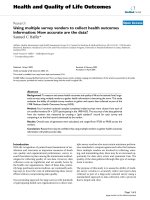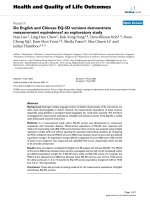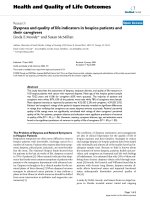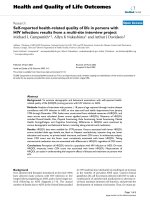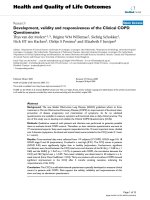Health and Quality of Life Outcomes BioMed Central Research Open Access Quality of life in lung potx
Bạn đang xem bản rút gọn của tài liệu. Xem và tải ngay bản đầy đủ của tài liệu tại đây (226.51 KB, 6 trang )
BioMed Central
Page 1 of 6
(page number not for citation purposes)
Health and Quality of Life Outcomes
Open Access
Research
Quality of life in lung cancer patients: does socioeconomic
status matter?
Ali Montazeri*
1,2
, David J Hole
2
, Robert Milroy
3
, James McEwen
2
and
Charles R Gillis
2
Address:
1
Iranian Institute for Health Sciences Research, Tehran, Iran,
2
Public Health and Health Policy, Division of Community Based Sciences,
University of Glasgow, Glasgow, Scotland, UK and
3
Department of Respiratory Medicine, Stobhill NHS Trust, Glasgow, Scotland, UK
Email: Ali Montazeri* - ; David J Hole - ;
Robert Milroy - ; James McEwen - ; Charles R Gillis -
* Corresponding author
Abstract
Background: As part of a prospective study on quality of life in newly diagnosed lung cancer
patients an investigation was carried out to examine whether there were differences among
patients' quality of life scores and their socioeconomic status.
Methods: Quality of life was measured at two points in time (baseline and three months after
initial treatment) using three standard instruments; the Nottingham Health Profile (NHP), the
European Organization for Research and Cancer Treatment Quality of Life Questionnaire (EORTC
QLQ-C30) and its lung cancer supplement (QLQ-LC13). Socioeconomic status for each individual
patient was derived using Carstairs and Morris Deprivation Category ranging from 1 (least
deprived) to 7 (most deprived) on the basis of the postcode sector of their address.
Results: In all, 129 lung cancer patients entered into the study. Of these data for 82 patients were
complete (at baseline and follow-up). 57% of patients were of lower socioeconomic status and they
had more health problems, less functioning, and more symptoms as compared to affluent patients.
Of these, physical mobility (P = 0.05), energy (P = 0.01), role functioning (P = 0.04), physical
functioning (P = 0.03), and breathlessness (P = 0.02) were significant at baseline. However, at
follow-up assessment there was no significant difference between patient groups nor did any
consistent pattern emerge.
Conclusion: At baseline assessment patients of lower socioeconomic status showed lower health
related quality of life. Since there was no clear trend at follow-up assessment this suggests that
patients from different socioeconomic status responded to treatment similarly. In general, the
findings suggest that quality of life is not only the outcome of the disease and its treatment, but is
also highly dependent on each patients' socioeconomic characteristics.
Background
Lung cancer is one of the common cancers among males
and females worldwide [1]. It is well known that lower
socioeconomic background as measured by educational
level, occupational status, house ownership and level of
income are all associated with an increased risk of lung
cancer [e.g. [2,3]]. Thus most lung cancer patients are
from disadvantaged populations. On the other hand since
Published: 9 June 2003
Health and Quality of Life Outcomes 2003, 1:19
Received: 18 February 2003
Accepted: 9 June 2003
This article is available from: />© 2003 Montazeri et al; licensee BioMed Central Ltd. This is an Open Access article: verbatim copying and redistribution of this article are permitted in all
media for any purpose, provided this notice is preserved along with the article's original URL.
Health and Quality of Life Outcomes 2003, 1 />Page 2 of 6
(page number not for citation purposes)
survival in lung cancer patients is poor, quality of life is
considered to be an important outcome in patients who
develop the disease [4]. Studies have shown that quality of
life in lung cancer patients is a significant predictor of sur-
vival and therefore it should be considered as a clinical
status that has to be established by physicians before treat-
ment starts [5]. However, little is known about quality of
life and its relationship to patients' socioeconomic status.
Few studies exist that address the issue in cancer patients
in general but controversial results have been reported.
Some showed that cancer patients of lower socioeco-
nomic status have lower health related quality of life [6],
and others found no significant difference between afflu-
ent and deprived cancer patients with regard to their qual-
ity of life [7]. In studies of quality of life in lung cancer
patients the only investigation that acknowledges the
issue of patients' socioeconomic status observed a greater
disruption in quality of life in patients with low income
[8].
This paper reports on data from a prospective study of
quality of life in lung cancer patients and examines
whether there is a difference in quality of life in lung can-
cer patients from different socioeconomic groups.
Methods
This was a prospective study of quality of life in lung can-
cer patients. The design, the method of data collection and
the study findings are explained elsewhere [9]. Here the
focus is on quality of life and patients' socioeconomic sta-
tus. In summary, patients' quality of life was assessed in
two points in time: baseline and three months after initial
treatment (follow-up) using three standard measures; the
Nottingham Health Profile (NHP) [10], the European
Organization for Research and Treatment of Cancer Qual-
ity of Life Questionnaire (EORTC QLQ-C30) [11], and the
EORTC Lung Cancer Questionnaire (EORTC QLQ-LC13)
[12]. Data were collected during one complete calendar
year (January to December 1995) with the intention of
interviewing all new lung cancer patients attending the
chest clinic of a large teaching and district general hospital
(Stobhill NHS Trust) in the northern sector of Glasgow.
Permission was obtained from the hospital ethics com-
mittee, clinicians, and the patients. Socio-economic status
was indicated by each patient's postcode of residence
using the Carstairs and Morris Deprivation Categories
[13]. This is a well-established measure of socioeconomic
status in Scotland and it ranges from 1 (least deprived) to
7 (most deprived). For the analysis, deprivation category
was recoded into two categories, affluent/intermediate
and deprived. Data on demographic characteristics of the
patients and clinical information including weight loss,
histology, extent of disease, and treatment were extracted
from case records. Since patients' scores in most measures
were not normally distributed, non-parametric tests were
applied. The Mann-Whitney test was carried out to test
whether patients scored differently based on their socioe-
conomic status.
Results
Patients' characteristics
Patients' characteristics are shown in Table 1. Seventy-
seven patients (60%) were male, the mean age was 67.5
years (SD = 9.1), mostly married (n = 77, 60%) and from
severely socioeconomic deprived areas (n = 74, 57%). The
majority of the patients had intrathoracic tumours (TNM
stage I-III; n = 101, 78%). Eighty-one patients (63%) had
an active treatment as their initial management (chemo-
therapy = 36, radiotherapy = 39, surgery = 6), whereas the
remaining 48 (37%) received 'best supportive care'.
At follow-up 96 (74%) patients were alive. Of these 82
(64%) agreed to be re-interviewed. Of the remaining 14
patients, 6 were terminally ill and 8 refused. Thus, only 82
patients who had complete data (baseline and three
months after) were used in the analysis. The treatment
modalities for those who were followed-up consisted of
chemotherapy (n = 25), radiotherapy (n = 29), surgery (n
= 6), and best supportive care (n = 22). However, the 82
patients who were followed up were similar to the 129
patients seen initially in terms of their baseline demo-
graphic and clinical characteristics. Further cross tabula-
tions between patients' demographic and clinical status
and deprivation category indicated that there were no sig-
nificant differences between patients of different social
background (data are not shown and is available from the
corresponding author).
General Health
Patients' general health as measured by the NHP is shown
in Table 2. Both at baseline and follow-up patients with
lower socioeconomic status showed higher perceived
health problems, although the difference was not signifi-
cant on almost all measures except for physical mobility
and energy at baseline assessment (P = 0.05, P = 0.01,
respectively).
Functioning and global quality of life
Patients' functioning and global quality of life scores as
measured by the EORTC QLQ-C30 are shown in Table 3.
In general deprived patients had lower functioning and
global quality of life at baseline. Of these, patients' role
and physical functioning were significantly different (P =
0.04, P = 0.03, respectively). However, at follow-up assess-
ment there were no significant differences between
patients groups. Deprived patients scored slightly higher
on three measures; cognitive, social and emotional func-
tioning and lower on other three measures; role and phys-
ical functioning and global quality of life (the higher
Health and Quality of Life Outcomes 2003, 1 />Page 3 of 6
(page number not for citation purposes)
Table 1: Lung cancer patients' socio-demographic and clinical characteristics
Baseline sample
(n = 129)
No. (%)
Follow-up sample
(n = 82)
No. (%)
Gender
Male 77 (60) 48 (58)
Female 52 (40) 34 (42)
Age (year)
Mean (SD) 67.5 (9.1) 66.2 (8.6)
Marital status
Married 77 (60) 50 (61)
Widowed/divorced 45 (35) 28 (34)
Single 7 (5) 4 (5)
Deprivation category
Affluent/intermediate 55 (43) 35 (43)
Deprived 74 (57) 47 (57)
Cell type
Small cell 27 (21) 18 (22)
Non-small cell 67 (52) 44 (54)
Unspecified 35 (27) 20 (24)
Extent of disease
Limited 101 (78) 70 (85)
Extensive 28 (22) 12 (15)
Initial treatment
Chemotherapy 36 (28) 25 (31)
Radiotherapy 39 (30) 29 (35)
Surgery 6 (5) 6 (7)
Best supportive care 48 (37) 22 (27)
Weight loss*
Possible weight loss 12 (9) 7 (9)
Significant weight loss 51 (40) 33 (40)
Weight steady 40 (31) 26 (32)
No comment 26 (20) 16 (19)
* Significant weight loss = 10% weight lost during 6 months prior to diagnosis. Possible weight lost = although it was not clear whether a patient had
a significant weight loss or not, the consultant commented in the case record that the patient had possible weight loss.
Table 2: Patients' baseline and follow-up scores on the NHP (the higher values indicate more perceived health problems, min.: 0, max.:
100)
Baseline Follow-up
Affluent/intermediate
(n = 35)
Mean (SE)
Deprived
(n = 47)
Mean (SE)
P*
Affluent/intermediate
(n = 35)
Mean (SE)
Deprived
(n = 47)
Mean (SE)
P*
Physical mobility 17.4 (3.6) 28.5 (3.9) 0.05 29.8 (4.4) 38. 9 (4.9) 0.20
Energy 22.4 (5.5) 41.9 (5.7) 0.01 44.1 (6.4) 56.3 (5.6) 0.15
Social isolation 10.6 (3.8) 13.2 (3.4) 0.43 17.8 (4.3) 19.7 (3.9) 0.81
Emotional reactions 19.2 (3.8) 25.0 (3.6) 0.20 24.6 (4.6) 32.1 (4.4) 0.29
Pain 15.6 (3.9) 25.2 (4.4) 0.06 21.9 (4.0) 27.9 (4.3) 0.37
Sleep 31.6 (4.9) 38.9 (4.9) 0.36 29.1 (5.1) 37.6 (4.7) 0.19
SE = standard error of mean. * Mann-Whitney test.
Health and Quality of Life Outcomes 2003, 1 />Page 4 of 6
(page number not for citation purposes)
values indicate a higher level of functioning and quality of
life).
Main Symptoms
Patients' baseline and follow-up symptom scores as meas-
ured by the EORTC QLQ-C30 and QLQ-LC13 are listed in
Table 4. At baseline except on one measure (pain in other
sites of the body) deprived patients showed a greater
degree of symptoms (12 out of 13 measures). Of these,
significant differences were observed on measures of
breathlessness (P = 0.02) and peripheral neuropathy (P =
0.01). However, at follow-up assessment there was no
clear trend and even in some measures such as pain, appe-
tite loss and financial difficulties less deprived patients
scored higher indicating that they had a greater degree of
symptoms and difficulties (Table 4).
Discussion
This was a prospective study of quality of life in lung can-
cer patients. The focus here was on patients' socioeco-
nomic status and its relationship to their quality of life.
Since there were no significant differences between
patients' demographic, clinical status and socioeconomic
status, there was no evidence to suggest that deprived
patients had more advanced disease at baseline. However,
it was found that in most measures deprived patients had
lower health-related quality of life. Performing more
advanced analysis (regression analysis), studies have used
overall health related quality of life as an outcome meas-
ure (sum of the five subscales of the Functional Assess-
ment of Cancer Therapy-FACT-Scale) with performance
status, disease site, disease stage, socioeconomic status,
spiritual beliefs, gender, and other relevant variables as
independent variables and found no significant effects of
socioeconomic status on the reporting of overall health
related quality of life [7]. However, it is worth noting that
studies that perform more advanced analysis have their
own limitations. The problem with more advanced analy-
sis is that calculated overall scores were used where the
instrument did not provide such summary measures and
this undermines the validity of the results reported.
There is a commonly held belief that patients of lower
socioeconomic status tend to have a worse quality of life
both at the time of disease diagnosis and following their
cancer treatment. This has been confirmed in studies of
quality of life in prostate cancer where socioeconomic sta-
tus was measured by annual income [14]. In contrast
when education was used as an indicator of socioeco-
nomic status, higher education was found to be independ-
ent predictor of worse quality of life following treatment
[15]. We used the Carstaris and Morris deprivation cate-
gory which is a well-validated index in Scotland for indi-
cating individuals' socioeconomic status based on place
of residence. Several studies of cancer epidemiology and
cancer care have used this index and showed that it is a
valid measure of socioeconomic status [16]. However, it is
important to notice that indicators of socioeconomic sta-
tus may differ within different societies and this should be
taken into account when such indexes are used to evaluate
quality of life.
Our findings indicated that patients from lower socioeco-
nomic backgrounds showed more problems with physical
mobility, energy, role and physical functioning. This dif-
ference was more marked at baseline indicating that
greater attention should be paid to improving those
domains which are important to patients' quality of life
especially those of lower social class. It has been shown
that functional impairment is the most important risk fac-
tor that contributes to increased depression in lung cancer
patients [17].
Considering patients' symptom scores it seems that at
baseline patients of lower socioeconomic status had more
symptoms compared to less deprived patients and these
were significant on measures of breathlessness, and
peripheral neuropathy. At follow-up the difference did
Table 3: Patients' baseline and follow-up functioning and global quality of life scores on the EORTC QLQ-C30 (the higher values indicate
a higher level of functioning and quality of life, min.: 0, max.: 100)
Baseline Follow-up
Affluent/intermediate
(n = 35)
Mean (SE)
Deprived
(n = 47)
Mean (SE)
P* Affluent/intermediate
(n = 35)
Mean (SE)
Deprived
(n = 47)
Mean (SE)
P*
Role functioning 72.8 (5.9) 58.5 (4.9) 0.04 52.8 (5.0) 41.5 (4.4) 0.09
Physical functioning 74.3 (3.7) 61.7 (3.8) 0.03 58.8 (4.2) 53.6 (3.6) 0.33
Cognitive functioning 85.2 (3.4) 86.9 (3.1) 0.69 77.6 (4.4) 83.0 (3.3) 0.34
Social functioning 86.6 (3.9) 85.8 (3.7) 0.96 80.9 (4.1) 82.9 (3.2) 0.77
Emotional functioning 80.0 (3.4) 78.2 (3.4) 0.84 74.5 (3.5) 76.8 (3.4) 0.41
Global quality of life 56.9 (3.3) 51.4 (3.5) 0.18 53.8 (4.3) 50.3 (3.8) 0.59
SE = standard error of mean. * Mann-Whitney test.
Health and Quality of Life Outcomes 2003, 1 />Page 5 of 6
(page number not for citation purposes)
not show a clear trend perhaps indicating that both
groups of patients responded to treatment in a similar
way. Similar findings have been reported in prostate can-
cer patients when comparing patients of lower socioeco-
nomic status with patients of higher social class [14].
In general the difference in quality of life measures was
more profound at baseline than at 3 months in patients of
lower socioeconomic status compared to that of higher
status patients. This might reflect the fact that baseline
quality of life is a better indicator when comparing quality
of life in patients with different socioeconomic back-
grounds. Such observation also might explain why base-
line quality of life is a significant predictor of survival
among lung cancer patients and other tumor types [5,18].
We used three standard instruments to measure quality of
life; a general health (NHP), a cancer-specific (QLQ-C30)
and a site-specific (QLQ-LC13) questionnaire. Of these,
the NHP showed a better performance in discriminating
between patient groups both at baseline and follow-up
assessments but the EORTC questionnaires were able to
show a trend only at baseline assessment. One
explanation is that the NHP was developed in the United
Kingdom and thus it was a more culturally sensitive
instrument. In contrast one might argue that since the
EORTC QLQ-C30 and QLQ-LC13 were cancer-specific,
these instruments were therefore more accurate in meas-
uring changes that happened over time. In other words if
these questionnaires did not show a clear trend at follow-
up assessment this may indicate that both patient groups
responded to treatment in a relatively similar fashion.
This may again prove that the role of socioeconomic sta-
tus is important at baseline but not at follow-up
assessments.
Conclusion
The findings indicated that patients of lower socioeco-
nomic status had more health problems, less functioning
and global quality of life, and a higher degree of symp-
toms at baseline assessment. However, at follow-up
assessment the results were not conclusive but in general
the findings suggest that quality of life is not only the out-
come of the disease, but is also highly dependent on each
patients' socioeconomic characteristics. The findings also
indicate that there is need for more investigation on the
topic as socioeconomic status plays an important role in
patients' perceptions of quality of life.
List of abbreviations
NHP: the Nottingham Health Profile; EORTC QLQ-C30:
the European Organization for Research and Treatment of
Cancer Quality of Life Questionnaire; EORTC QLQ-LC13:
the European Organization for Research and Treatment of
Cancer Lung Cancer Questionnaire; FACT: the Functional
Assessment Cancer Therapy Scale; SF-36: the Short Form
Health Survey; SE = Standard error of mean.
Competing interest
None.
Authors' contribution
AM was the main investigator, collected and analyzed the
data, and wrote the paper. DJH contributed to analysis of
the data and final draft of the paper. RM contributed to
the study design, patient recruitment and data collection.
Table 4: Patients' baseline and follow-up symptoms scores on the EORTC QLQ-C30 and QLQ-LC13 (the higher values indicate a
greater degree of symptoms, min.: 0, max.: 100)
Baseline Follow-up
Affluent/intermediate
(n = 35)
Mean (SE)
Deprived
(n = 47)
Mean (SE)
P* Affluent/intermediate
(n = 35)
Mean (SE)
Deprived
(n = 47)
Mean (SE)
P*
Cough 44.7 (5.8) 53.9 (4.2) 0.19 33.3 (4.3) 41.1 (4.8) 0.33
Haemoptysis 9.5 (3.7) 11.3 (3.5) 0.72 1.0 (0.9) 6.4 (2.8) 0.11
Dyspnoea 27.8 (4.6) 41.6 (3.7) 0.02 30.7 (4.4) 39.5 (4.1) 0.17
Pain (overall) 23.3 (3.7) 24.8 (3.9) 0.92 25.2 (4.7) 23.7 (4.2) 0.52
Pain in chest 16.2 (4.2) 26.2 (4.4) 0.12 22.8 (4.9) 25.5 (5.0) 0.91
Pain in shoulder 17.1 (4.6) 19.8 (4.1) 0.62 28.6 (6.0)) 24.1 (4.7) 0.61
Pain elsewhere 25.7 (5.1) 15.6 (4.0) 0.07 22.8 (4.9) 18.4 (4.4) 0.37
Fatigue 26.0 (4.2) 38.3 (4.3) 0.06 34.9 (4.3) 43.7 (4.0) 0.17
Nausea and vomiting 7.6 (2.3) 7.8 (2.6) 0.65 15.2 (3.9) 9.9 (2.6) 0.35
Peripheral
neuropathy
3.8 (3.0) 18.4 (4.7) 0.01 19.0 (4.6) 16.3 (3.8) 0.66
Appetite loss 22.8 (4.5) 36.9 (5.4) 0.12 33.3 (5.4) 31.2 (5.0) 0.68
Sleep difficulties 27.6 (5.7) 31.2 (5.6) 0.81 24.7 (4.8) 24.8 (5.2) 0.66
Financial difficulties 6.6 (3.0) 8.5 (3.1) 0.87 11.4 (4.5) 7.1 (3.2) 0.40
SE = standard error of mean. * Mann-Whitney test.
Publish with BioMed Central and every
scientist can read your work free of charge
"BioMed Central will be the most significant development for
disseminating the results of biomedical research in our lifetime."
Sir Paul Nurse, Cancer Research UK
Your research papers will be:
available free of charge to the entire biomedical community
peer reviewed and published immediately upon acceptance
cited in PubMed and archived on PubMed Central
yours — you keep the copyright
Submit your manuscript here:
/>BioMedcentral
Health and Quality of Life Outcomes 2003, 1 />Page 6 of 6
(page number not for citation purposes)
JM and CRG contributed to study design and supervised
the project.
References
1. International Association of Cancer Registeries: Cancer incidence,
mortality and prevalence worldwide (2000 estimates) [http://
www-dep.iarc.fr/globocan/globocan.html].
2. Hein HO, Suadicani P and Gyntelberg F: Lung cancer risk and
social class Danish Med Bull 1992, 39:173-176.
3. van Loon AJ, Goldbohm RA and van den Brandt PA: Lung cancer: is
there an association with socioeconomic status in the
Netherlands? J Epidemiol Community Health 1995, 49:65-69.
4. Montazeri A, Gillis CR and McEwen J: Quality of life in lung cancer
patients. A review of literature from 1970–1995 Chest 1998,
113:467-481.
5. Montazeri A, Milroy R, Hole D, McEwen J and Gillis CR: Quality of
life in lung cancer patients. As an important prognostic
factor Lung Cancer 2001, 31:233-240.
6. Penson D, Litwin M, Lubeck D, Flanders S, Pasta D and Carroll P:
Transition in health-related quality of life during the first
nine months after diagnosis with prostate cancer Prostate Can-
cer Prostatic Dis 1998, 1:134-143.
7. Wan GJ, Counte MA, Cella DF, Hernandez L, McGuire DB, Deasay S,
Shiomoto G and Hahn EA: The impact of socio-cultural and clin-
ical factors on health-related quality of life reports among
Hispanic and African-American cancer patients J Outcome
Meas 1999, 3:200-215.
8. Sarna L: Women with lung cancer: impact on quality of life
Qual Life Res 1993, 2:13-22.
9. Montazeri A, Milroy R, Hole D, McEwen J and Gillis CR: How quality
of life data contribute to our understanding of cancer
patients' experiences? A study of patients with lung cancer
Qual Life Res 2003, 12:157-166.
10. Hunt SM, Mckenna SP and McEwen J: The Nottingham Health
Profile User's Manual Manchester, Galen Research 1993.
11. Aaronson NK, Ahmedzai S and Bergman B: The European Organ-
ization for Research and Treatment of Cancer QLQ-C30: a
quality of life instrument for use in international clinical trials
in oncology J Natl Cancer Inst 1993, 85:365-642.
12. Bergman B, Aaronson NK, Ahmedzai S, Kaasa S and Sullivan M: The
EORTC QLQ-LC13: a modular supplement to the EORTC
Core Quality of Life Questionnaire (QLQ-C30) for use in
lung cancer clinical trials Eur J Cancer 1994, 30:635-642.
13. Carstairs V and Morris R: Deprivation and Health in Scotland
Aberdeen, Aberdeen University Press 1991.
14. Penson DF, Stoddard ML, Pasta DJ, Lubeck DP, Flanders SC and
Litwin MS: The association between socioeconomic status,
health insurance coverage, and quality of life in men with
prostate cancer J Clin Epidemiol 2001, 54:350-358.
15. Litwin MS, McGuigan KA, Shpall AI and Dhanani N: Recovery of
health-related quality of life in the year after radical prosta-
tectomy: early experience J Urol 1999, 161:515-519.
16. Scottish Cancer Intelligence Unit: Trends in Cancer survival in
Scotland 1971–1995 Edinburh, Information & Statistics Division,
National Health Service in Scotland 2000.
17. Hopwood P and Stephens RJ: Depression in patients with lung
cancer: prevalence and risk factors derived from quality of
life data J Clin Oncol 2000, 18:893-903.
18. Dancey J, Zee B and Osoba D: Quality of life scores: an inde-
pendent prognostic variable in a general population of can-
cer patients receiving chemotherapy Qual Life Res 1997, 6:151-
158.


